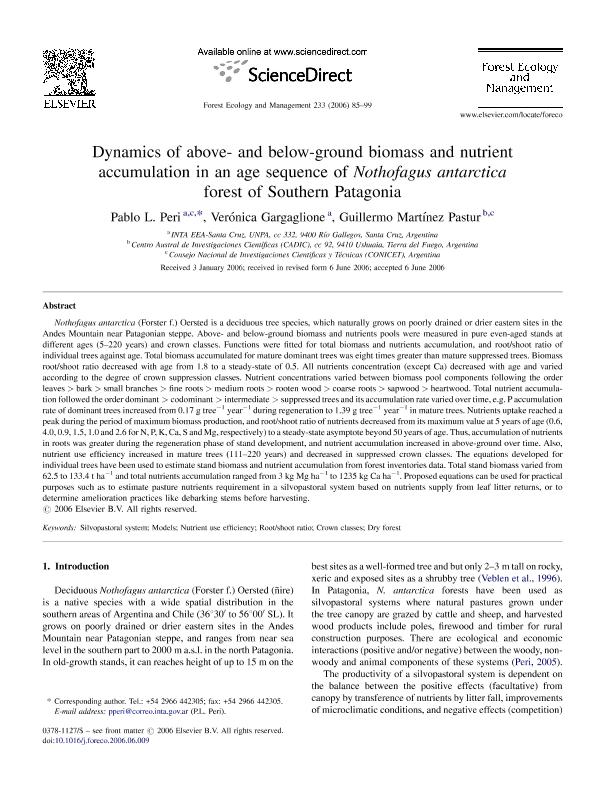Artículo
Dynamics of above- and below-ground biomass and nutrient accumulation in an age sequence of Nothofagus antarctica forest of southern Patagonia
Fecha de publicación:
09/2006
Editorial:
Elsevier Science
Revista:
Forest Ecology and Management
ISSN:
0378-1127
Idioma:
Inglés
Tipo de recurso:
Artículo publicado
Clasificación temática:
Resumen
Nothofagus antarctica (Forster f.) Oersted is a deciduous tree species, which naturally grows on poorly drained or drier eastern sites in the Andes Mountain near Patagonian steppe. Above- and below-ground biomass and nutrients pools were measured in pure even-aged stands at different ages (5–220 years) and crown classes. Functions were fitted for total biomass and nutrients accumulation, and root/shoot ratio of individual trees against age. Total biomass accumulated for mature dominant trees was eight times greater than mature suppressed trees. Biomass root/shoot ratio decreased with age from 1.8 to a steady-state of 0.5. All nutrients concentration (except Ca) decreased with age and varied according to the degree of crown suppression classes. Nutrient concentrations varied between biomass pool components following the order leaves > bark > small branches > fine roots > medium roots > rooten wood > coarse roots > sapwood > heartwood. Total nutrient accumulation followed the order dominant > codominant > intermediate > suppressed trees and its accumulation rate varied over time, e.g. P accumulation rate of dominant trees increased from 0.17 g tree 1 year 1 during regeneration to 1.39 g tree 1 year 1 in mature trees. Nutrients uptake reached a peak during the period of maximum biomass production, and root/shoot ratio of nutrients decreased from its maximum value at 5 years of age (0.6, 4.0, 0.9, 1.5, 1.0 and 2.6 for N, P, K, Ca, S and Mg, respectively) to a steady-state asymptote beyond 50 years of age. Thus, accumulation of nutrients in roots was greater during the regeneration phase of stand development, and nutrient accumulation increased in above-ground over time. Also, nutrient use efficiency increased in mature trees (111–220 years) and decreased in suppressed crown classes. The equations developed for individual trees have been used to estimate stand biomass and nutrient accumulation from forest inventories data. Total stand biomass varied from 62.5 to 133.4 t ha 1 and total nutrients accumulation ranged from 3 kg Mg ha 1 to 1235 kg Ca ha 1 . Proposed equations can be used for practical purposes such as to estimate pasture nutrients requirement in a silvopastoral system based on nutrients supply from leaf litter returns, or to determine amelioration practices like debarking stems before harvesting.
Palabras clave:
Silvopastoral system
,
Models
,
Nutrient use efficiency
,
Root/shoot ratio
Archivos asociados
Licencia
Identificadores
Colecciones
Articulos(CADIC)
Articulos de CENTRO AUSTRAL DE INVESTIGACIONES CIENTIFICAS
Articulos de CENTRO AUSTRAL DE INVESTIGACIONES CIENTIFICAS
Articulos(SEDE CENTRAL)
Articulos de SEDE CENTRAL
Articulos de SEDE CENTRAL
Citación
Peri, Pablo Luis; Gargaglione, Veronica Beatriz; Martínez Pastur, Guillermo José; Dynamics of above- and below-ground biomass and nutrient accumulation in an age sequence of Nothofagus antarctica forest of southern Patagonia; Elsevier Science; Forest Ecology and Management; 233; 1; 9-2006; 85-99
Compartir
Altmétricas




